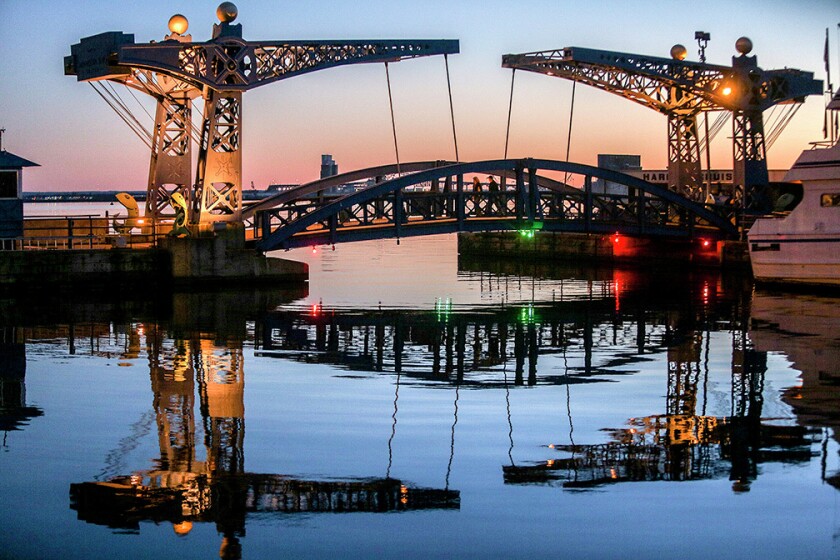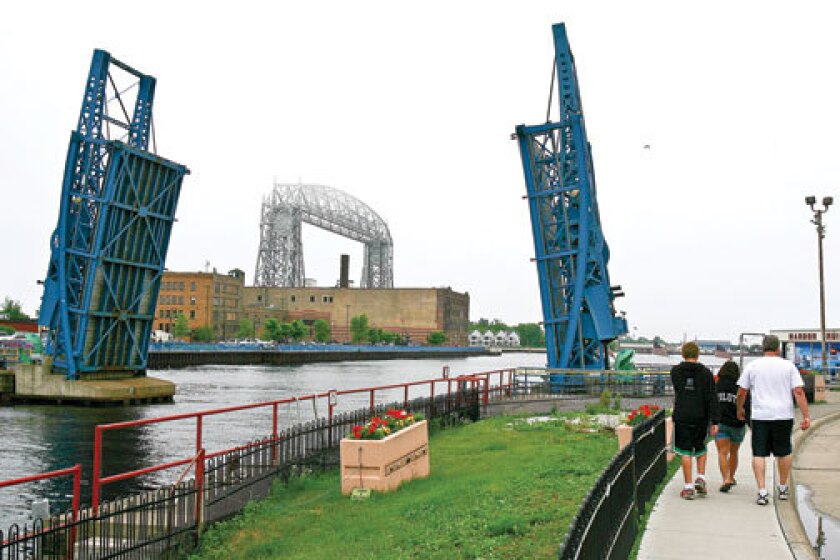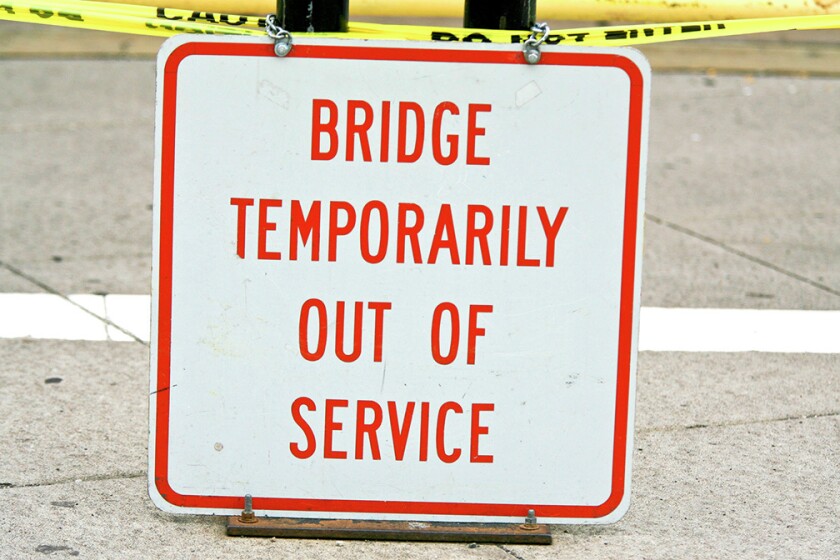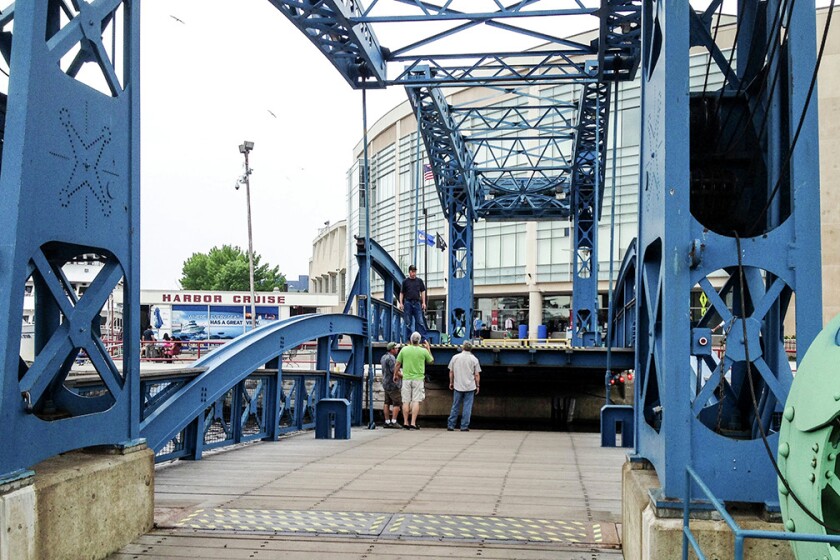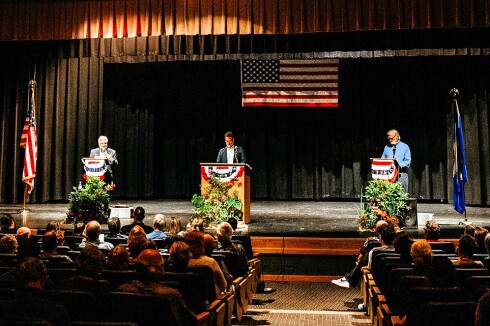When the blue pedestrian lift bridge that crosses Duluth’s Minnesota Slip fails, as it frequently does, the result is more than just an inconvenience. It’s bad for business.
Just ask Dan Russell, executive director of the Duluth Entertainment Convention Center. He explained that when the bridge is out of commission, convention-goers staying at Canal Park hotels face a longer-than-anticipated walk that can make them late for morning meetings.
Russell said the bridge malfunctions have been a recurring aggravation that has led some convention planners to reconsider booking events in Duluth.
This year, mechanical difficulties rendered the bridge inoperable for 32 days, and it was forced out of commission for yet another 10 days because of strong winds.
Russell said the blue bridge has suffered frequent breakdowns since it first opened in 1991.
“It wasn’t well-designed to begin with,” he said.
Russell questioned the wisdom of continued attempts to fix the bridge, versus replacing it.
“It’s sort of like when you have a problem car that you’re just constantly pouring money into,” he said.
Brian Daugherty, president of Grandma’s Restaurant Co., said bridge operations affect the bottom line for people operating businesses in Canal Park.
He described the blue bridge as the main connector between the DECC and Canal Park, adding: “When that bridge is removed from the equation, it can affect restaurant sales as much as 30 percent that day, if there’s an event going on, whether it’s a convention, a concert or a hockey game.”
Grandma’s patrons often express their frustrations with the problematic bridge, according to Daugherty, who said: “There is much disdain and disappointment when that bridge is stuck in the up position.”
Debbie Bolen, owner of the Rocky Mountain Chocolate Factory in Canal Park, said her business has had a strong year, but it could have been even better if not for bridge breakdowns.
“We do lose some business when it’s not working,” she said, noting that she feels the impact of an inoperable bridge more on the weekdays than the weekends. Bolen said in years past, her shop even has resorted to impromptu discounts she called “broken-bridge sales.”
But Bolen said she’s more embarrassed for Duluth than anything.
“It doesn’t reflect well on the city. It doesn’t look like we know what we’re doing,” she said.
Mayor Don Ness suggested the city consider filling in the slip in 2013, but acknowledged the idea was not well-received.
“It was quite frustrating for me ... to see so much pushback ... without consideration of what it would cost to maintain the status quo, just this knee-jerk push to say: It can’t be anything else other than what it is today,” he said.
Yet Ness still stands behind the idea.
“It has been in a bit of a holding pattern, but I am more convinced than ever that that is the right action for this community,” he said.
While the issue is unlikely to be resolved in his final two months as mayor, Ness explained why he favors a fill-in option.
He pointed to the cost of dealing with contaminated sediments in Minnesota Slip that have been flagged as a concern by the Minnesota Pollution Control Agency. Ness suggested that filling it in would be significantly less expensive than the $5 million to $7 million anticipated cost of remediation in an open-water setting. In contrast, initial estimates put the cost of filling the slip at about $2 million.
Ness also noted that the seawalls supporting the slip are failing and will need to be replaced soon at an estimated cost of about $3 million if it is to be safely preserved.
Then, there’s also the cost of replacing the bridge, which Ness placed at a ballpark price of $3.3 million two years ago.
“If money is not an issue, people would prefer the status quo, but I think it’s important that the community actually see very clearly the costs associated with maintaining and fixing the status quo and take that into consideration when deciding between these two options,” he said.
Daugherty said he likes the idea of filling in the slip not only because it would allow the city to scrap the blue bridge, but also because it could address the need for more parking in Canal Park.
But Russell is no fan of the idea of displacing the William A. Irvin, a retired laker that floats prominently in Minnesota Slip, where DECC staff operate it as a floating museum.
“I think the Irvin is the second-most iconic sight in our city. It just screams Duluth,” he said, ranking the ship right behind the Aerial Lift Bridge.
Ness suggested the Irvin could be relocated to another prominent location and said charter boats that also now operate out of the slip could be accommodated in a new marina he proposed to establish in the harbor, following the construction of a breakwall at a reasonable cost.
He estimated that filling in the slip could lead to the creation of about 270 new parking spots in Canal Park. Ness said the only alternative way to achieve a comparable boost in parking capacity would be to build a Canal Park parking ramp at a cost of around $6 million.
But Russell said he still favors leaving the Irvin at its current mooring and replacing the problem bridge.
As he reflected on the mayor’s proposal, Russell said he was reminded of a famous Joni Mitchell lyric: “They paved paradise and put up a parking lot.”
Ness’ soon-to-be seated successor, mayor-elect Emily Larson, said she remains undecided about the fate of the slip and bridge but agreed that putting off a fix for much longer would be unwise.
“How it’s working now is not working, literally,” she said.
Larson said recent information she has received about the numerous disruptions caused by bridge malfunctions this year has pushed the issue far up her list of priorities.
“I understand why this is such a critical issue for Canal Park vendors and visitors. Last summer, it had serious financial implications, especially for the DECC,” she said.
Larson, who will take office as mayor in January, said she’s eager to get to work on the issue.
“Hopefully there are some conversations that we can have early on, so that people can have some confidence moving into the next tourism season of what they can expect for a plan that will address this problem moving forward,” she said.
Ness said he wishes he wasn’t pushing the problem onto Larson’s plate.
“We’re probably beyond the point where a decision should have been made,” he said.
“That was my hope in bringing this forward a couple of years ago, that there could have been some forward momentum. You know, we certainly could have kept this on a fast track and pushed the discussion forward, but it became very clear the community wasn’t ready for that, and there wasn’t the support necessary,” Ness said.
ADVERTISEMENT

